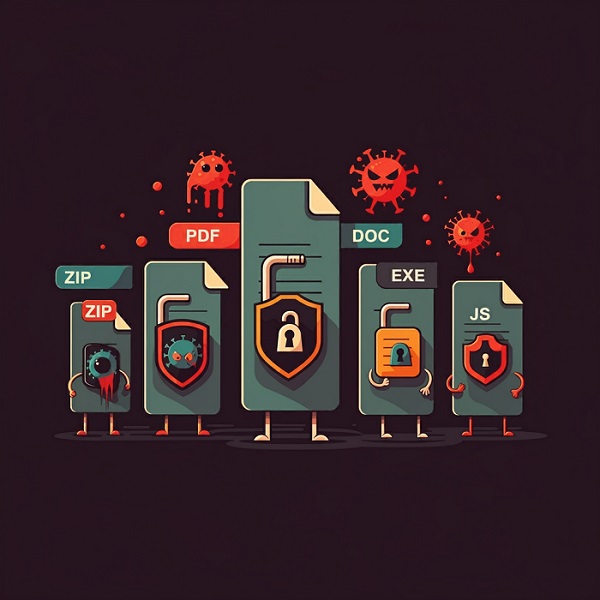Malware is crafty, often lurking in the files we use every day, waiting to catch us off guard. From innocent looking documents to familiar programs, these threats can be hiding anywhere. In this guide, we’ll explore five common file types that can harbor malware and help you better understand the risks they pose to your devices and files..
1. Executable Files (EXE)
Executable files are the key to running most programs on a Windows system. Think of your favorite applications. maybe you’ve downloaded Google Chrome or Spotify. These programs come as EXE files. When you click to open them, they run code that launches the program. However, the same process is used by malware disguised as harmless software.
Imagine downloading a game from an unofficial website. It might look like a legitimate game installer with the familiar .exe extension. But when you run it, instead of getting your game, it silently installs malware that could steal your personal information. A notorious example of this is fake antivirus programs. You download what looks like legitimate antivirus software, only to find it’s actually a virus in disguise. This is a common old tactic used by rogue security software developers to trick users into installing a software that when launched will inform you that your computer is infected so they would pay for a fake virus remover.
2. Compressed Files: ZIP/RAR
ZIP or RAR files are convenient when sharing multiple files, but they can also be sneaky. Just like a box of chocolates—you never know what’s inside until you open it—compressed files can contain a variety of files, including those that might be harmful.
For instance you need a website template. You find a zip file containing HTML, CSS, and JavaScript online that promises to output a beautiful design. After downloading and unzipping it, you see a list of files with the extensions .html and .css files as expected—but buried within, there’s an executable .exe file that you weren’t expecting or worst still, the bad actor knows you will likely notice the exe file, will inject a malicious JavaScript code inside the .html file or inside the .js file, then you run this malicious codes along with others. If you’re not careful you might just unleash malware onto your system that will wreck havoc or be stealing your data and sending to a remote server.. This is how viruses like CryptoLocker spread, often hiding in ZIP files, waiting to encrypt your data and demand ransom. Am not saying downloading website templates are bad, you need to decompile and check every file very well before deploying to your project.
3. PDF Files
PDFs are everywhere, whether you’re receiving an electronic invoice, an eBook, or a business contract, you’ve probably opened hundreds of them without a second thought. But not all PDFs are innocent. Some contain embedded code that can execute malicious actions when opened.
PDFs are a common tool for phishing attacks. PDF was used in a phishing attack that targeted Wells Fargo customers. The attached PDF looked like a legitimate bank document, but opening it allowed attackers to steal personal information by exploiting vulnerabilities in the PDF reader software.
4. Script Files (JS, PY, SH)
Scripts are files containing commands that your computer can execute. JavaScript files (.js), Python scripts (.py), or Shell scripts (.sh) are popular among developers, but in the wrong hands, they can be dangerous. These scripts need to be run by the user, but if you’re tricked into executing infected ones, it’s game over.
For instance, Let’s say you’re browsing a website, and you see a tempting free offer to download some custom fonts. The download comes as a .zip file, and when you extract it, you see a .js file. You think it’s part of the font package, but running it can activate malware in your browser. We’ve seen cases in malvertising campaigns, where malicious JavaScript files were embedded in ads, which when clicked, installed malware directly onto the user’s system.
5. Microsoft Office Files (DOC, XLS, PPT)
We’ve all used Microsoft Office files, Word documents, Excel spreadsheets, and PowerPoint presentations. But did you know these files can carry dangerous macros? Macros are small programs embedded within documents that can automate tasks, but they can also be programmed to install malware.
Example scenario: You receive an email from a colleague with a Word document attached, titled “Q3 Sales Projections.” It seems legitimate, and since it’s from someone you know, you open it. But as soon as you do, the file asks you to “Enable Macros.” If you click yes, the macro activates, running a malicious script that installs a keylogger onto your system. This is a tactic that’s been widely used in phishing attacks targeting businesses, with malware like Dridex being spread through Excel files containing malicious macros.
Tips to Avoid Malware
These file types are commonly exploited to spread malware, however, no file type is completely safe from being compromised. Even images or audio files could be manipulated to carry a virus. However, the best defense is awareness and vigilance. Here are some practical steps to protect yourself:
- Be Skeptical of Unexpected Attachments: Even if an email comes from someone you know, verify they actually sent the file. Cybercriminals often impersonate contacts to trick you into opening dangerous attachments.
- Scan Before You Open: Whether it’s an EXE or a ZIP file, run an antivirus scan on any file you download from the internet. Tools like Windows Defender or Malwarebytes can help catch malicious files before they wreak havoc.
- Avoid Macros: Macros should be disabled in Microsoft Office by default. Only enable them if you are absolutely sure that the file is safe and you understand what the macro does.
- Keep Software Up-to-Date: Whether it’s your browser, PDF reader, or operating system, always make sure you have the latest security updates installed. Outdated software is one of the most common targets for malware attacks.
- Don’t Click on Everything: When downloading files, especially from websites or links in emails, use your best judgment. If something feels off, it probably is.
Viruses are masters of disguise, often hiding in the file types we trust most. Whether it’s an executable program, a compressed file, a simple PDF, a script, or a Microsoft Office document, being aware of the risks and using caution can help keep you safe.



